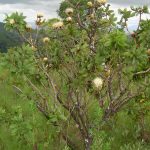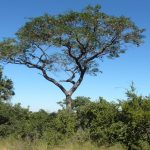TREE LIFE
October 1988
HARARE CALENDAR
NYANGA : l – 2 OCTOBER : THIS HAS BEEN POSTPONED UNTIL FIRST WEEKEND IN DECEMBER
If any one would still like to join the trip please contact Meg Coates Palgrave, 12 Kariba Crescent, Hillside, Harare. Telephone 734419
Tuesday, 4th October : Botanic Garden Walk: Meet in the Car Park at 1645 for 1700 hours.
Sunday 16th October : This is a trip to look forward to! Dunaverty Farm, Mtepatepa Bindura District. At last we are able to take up Barbara McKersie’s long-standing invitation to share her special piece of Africa. An Express Motorways coach has been arranged which will depart from the Park Lane car park behind Monomatapa at 0815 hours. Fare $18. Please phone Joy Killian at Harare 308398 if possible by Thursday 13th.
Saturday 22nd October : The monthly meeting at Mukuvisi Woodlands, Harare. Meet at 1500 hours at Paget Road /Inyanga Crescent gate.
Sunday 20th November : Christon Bank, Botanic Garden Extension. Probably meet at venue by own transport.
Tuesday 6th December : Botanic Garden Walk at 1700 hours.
MATABELELAND CALENDAR
On Sunday October 2nd, we go to Mopani Farm, Mr Acutt. This is mainly a Kalahari Sand Area. It will be a shorter morning trip. Meet at 8.30 a.m. in the Municipal Car Park, by the city Hall.
MATABELELAND NOTES , –
On Sunday, September 4th we went to Inyankhuni Dam where good planning had been arranged with a cottage as our base. Although this large dam is only just over half full, there was still a lot of water. We identified some 55 tree species, in a fairly short morning, and in the afternoon we drove round Inyankhuni then past Lower Ncema Dam, to Upper Ncema Dam all adding to the interest. Among the Acacias, A. robusta, near to Bulawayo was frequent, all in fine full flower. Then nearer the dams, many Knobthorn, A. nigrescens flowering well. Some of the more distant ones may well have been A. galpinii flowering early this year. Albizia amara, A. antunesiana, then A. tanganyicensis in full flower. Aloe excelsa (later, incidentally, at Upper Ncema Dam many A. cryptopoda below and beyond the dam wall, one solitary one was flowering very handsomely. Of course there were many Dombeya rotundifolia, flowering white along the roads, and in the hills and along the road was a rarer one, in deep pink flower, quite a few Azanza garckeana, Bolusanthus speciosus, Bridelia mollis. Many Burkea africana, yellowing, Cassia abbreviata, flowering here and there. Some largish leaved Cassine matabelica. Many yellowing Combretum apiculatum all contributing to the very yellow hillsides around. Combretum hereroense, some good specimens of C .imberbe, Commiphora africana, leafless, but I think still so, as the bark has a greyer tendency than C. schimperi,
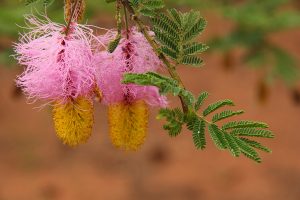
Dichrostachys cinerea. Photo: Petra Ballings. Source : Flora of Zimbabwe
Dichrostachys cinerea, some even flowering already, Diplorhynchus condylocarpon, yellowing Ficus abutilifolia, many Flacourtia indica, some very red, both dark and light. Grewia flavescens, G. monticola, Lonchocarpus capassa, Maytenus senegalensis, Ochna pulchra, Ozoroa insignis, subsp. reticulata varying a bit. Pappea capensis, Peltophorum africanum, many well coloured Pseudolachnostylis maprouneifolia, Pterocarpus rotundifolia, widespread, Rhus leptodictya, Sclerocarya birrea, Strychnos madagascariensis, S. pungens, Tarchonanthus camphorates, Tarenna neurophylla, a few Terminalia sericea, Vepris zambeziaca, with strong citrus smell and narrowly winged petiole, trifoliate, Vitex payos and many smallish but sharp Zisyphus mucronata, as I know to my cost again.
C. Sykes
MATABELELAND –TREES, ALOES AND FORTS, Sunday September 11th
Not only was the weather warm in Bulawayo but so was the welcome I received. I was delighted to find that although I had missed-the first Sunday of the month there was an extra outing with the Aloe and Cactus Society that weekend, and I accepted with alacrity an invitation to join a trip looking at various historical sites in the Mangwe area.
Although very dry the veld was full of interest and beauty as the early flowering trees were in full bloom. Acacia galpinii, Monkey thorn, was conspicuous and easily distinguishable in bud with it’s maroon-red calyxes and in flower, the yellow spikes with tinges of maroon showing through. Yellow flowers in spikes is another unusual feature as usually the flowers of Acacias which are in spikes are white or creamy in colour. Acacia galpinii is a tall upright species with a dark bark, longitudinally furrowed with a tendency to anastomose. Acacia nigrescens, Knobthorn, also has maroon calyxes but the colour disappears completely when the flowers open.. The flowers, also in spikes, are whitish and, of course, knobs can usually be found on the trunk or branches. Both species bloom early in the season. Also in bloom and very beautiful was Acacia robusta subsp. robusta. The white flowers, in little bells, showing up against the fresh green of the new leaves. This tree is very different in stature from the other subspecies clavigera which I know from the Zambezi Valley. The leaves are also very different. A. robusta subs. robusta has a glabrous rachis and only 2-3 pairs of pinnae while A. robusta subsp. clavigera has leaves with a densely hairy rachis, 5-6 pairs of pinnae and much smaller leaflets. Dombeya rotundifolia, wild pear, was every where. One realizes how common they are when seen in bloom. Combretum collinum, the pale creamy flowers in spikes and are heavily scented, was also conspicuous.
After a stop at the farmhouse for a delicious tea and a look at the zorses and zonkeys (horses end donkeys with zebra stripes on their rumps, the result of zebras having mated with horses and donkeys) we went to look at the first historical site which was on top of a kopje with a magnificent view of the surrounding countryside.
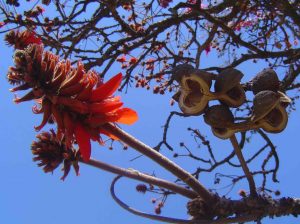
Erythrina latissima. Photo: Bart Wursten. Source: Flora of Zimbabwe
Erythrina latissima was coming into bloom. This was easy to identify positively as E. abyssinica does not occur in that part of the country. Where the cars were parked at the bottom of the dwala was a patch of mopane woodland in which were Aloe aculeata, Ormocarpum trichocarpum with its little bristly pods and Euclea undata which I did not recognize as it is a species new to me. In habit looks a like Euclea crispa and the leaves are like short E .divinorum also without hairs but with small scales or glands. We visited a small Pioneer Cemetery and then went on to the ruins of John Lee’s house. John Lee was the first non-missionary European to settle in the country. He was a friend and adviser of both Mzilikazi and Lobengula and therefore refused to lead the Settlers during the Matabele war. He first came to this country in l866 and when he married he wanted his wife to join him which she agreed to do provided he built her a proper house. This he did. The remains of the thick dry stone walls are still visible and the stables formed part of the house to protect the horses from wild animals. There is a story that on one occasion John Lee found a lion in the pantry so he quickly shut the door, went round to the window and shot the lion from there. The old road to Bulawayo from the south was guarded by seven forts each a days ride from each other. We visited three of them. The first was Mangwe which was dug into the ground with a ditch round it and next to a tall Diospyros mespiliformis which was used as a look out. Lunch was enjoyed next to the Mangwe Dam, built in 1986 to supply water to Plumtree about 35 km away. Mangwe Pass was a great disappointment to me. It was a narrow passage through the rocks and now, with modern earth-moving equipment, a road has been cleared round the other side of one of the boulders and on which there is a memorial marking the spot. Mollineaux fort has the remains of the old flag post on top. After a visit to the original Figtree, a Ficus thonningii, where visitors to Lobengula waited for permission to proceed, as the sun sank in the sky we sat at the site of Marquand fort and enjoyed the beauty of a magnificent grove of Acacia galpinii in flower. A lovely day and many thanks to all concerned.
-Meg Coates Palgrave
BOTANIC GARDEN WALK, SEPTEMBER 1988
As Tom was in Europe we decided to revise a few of the trees we may see when we visit the Trace’s cottage in Nyanga in October.
We began with a tree that had alternate leaves held in the flat, pre-pressed plane which we have learned to associate with the ANNONACEAE. But beware! The EUPHORBIACEAE mimics many other families (e.g. the CACTACEAE and SAPOTACEAE) any many look alike members of the ANNONACEAE. The first critical difference is that the EUPHORBIACEAE have stipules whereas the ANNONACEAE do not. Re-examining this shrub revealed large stipules that are deciduous and leave a distinct stipular scar, the plant Antidesma venosum, the Tasselberry. If the stipules are absent and the stipular scar unclear then the second test is to examine the leaf against the light with a lens – the ANNONACCEAE all have fine gland dots which are absent from the EUPHORBIACEAE. In some cases the crushed leaf releases the oils that are produced by these glands and these can be detected as a spicy, slightly citrus smell. We then approached
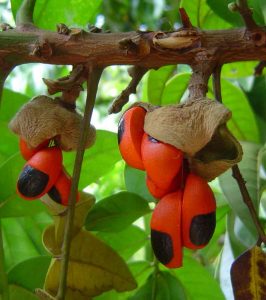
Trichilia dregeana. Photo: Bart Wursten. Source: Flora of Zambia
Trichilia dregeana, also from the Eastern Highland forests. I recently taught with Mr Mashava from Mutoko High who told me that the fruit (tsikiri) of this tree (mutsikiri) are commonly soaked in water until they soften. These are then squashed by hand and strained. The filtered juice is used as a vegetable stock for relish.
Beyond the Trichilia is Halleria lucida with distinctive orange flowers on the trunk and branches. The growth pattern is characteristic with sweeping horizontal branches with opposite, serrated leaves. It is an under-storey tree of the forest around Pungwe Falls.
Above the Halleria is a tall Newtonia buchananii. It looks like a fine leaved Albizia except that it has glands similar to those of Cassia singueana between every pair of pinnae. In the forest the leaves are often out of reach and then one looks for fallen pods which do not split into two but open up along one side like a folder. The winged seeds are long and flat, unlike any Albizia. After wandering past the Albizia gummifera, A. schimperiana, Polyscias fulva and Anthocleista grandiflora we set off to examine the Fernandoa magnifica in full flower. The rich nectar is worth tasting every year. We will not see this tree in Nyanga but judging from the enthusiasm I think we may see a few more planted around Harare.
-Kim Damstra
SUNDAY 18TH SEPTEMBER 1988 : OUTING TO CHAMWENO FARM, ENTERPRISE
Thanks to Peter and Francis Howson we found ourselves at Chabweno Farm on the Shamva road on a pleasant, warm morning that still held a nip in the wind. Gilbert Vanderstickelen gave us a quick run-down on the Geomorphology of the area, pointing out on the horizon the African Cycle some eighty million years old, and subsequent erosional effects. We knew that this was to be a day of contrasts and surprises because the engine of the aircraft carrying sky-divers from the local club started up while we were still trying to imagine the time-span that Gilbert had mentioned, and a world where some of our modern mammals were just beginning to develop but in which man had, as yet, no presence. We lost, temporarily, the entire gathering in the long grass, but this was soon left behind and we skirted a granite whale back before starting to climb its more gentle slope. We were diverted temporarily to admire some rock paintings, mostly, unfortunately, indistinct or exfoliated. Of interest, however, were three human figures with either enlarged heads or carrying something on their shoulders. The left arm of two of these figures were bent as though supporting a load. A separate elongated apparently legless figure with large upper arms, symmetrically squared shoulders; and an elongated head, also caused some speculation. Farther into this small cave roosted a Barn Owl, apparently quite unimpressed by the influx of strangers.
But what about the trees? Well, we made 106 ticks on our list this day. We were lucky to find Ochna schweinfurthiana flowering, as the flowers of this genus only last for a very short time. Also flowering for our delight were Euphorbia matabelensis, Clerodendrum myricoides, Elephantorrhiza goetzei, Acokanthera oppositifolia. Bequartiodendron magalismontanum and (saving the best until last)
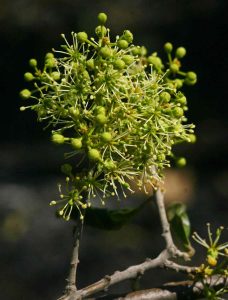
Boscia salicifolia. Photo: Bart Wursten. Source: Flora of Zimbabwe
Boscia salicifolia. These were the stars. The corps de ballet was made up of Eriosima engleranum, Leonotis nepatifolia, Resinosa resiniflua, Partansia achweinfurthii, Viga nuda, Bacium obovatum and several other shrubs and plants. Kim discovered, to his intense satisfaction, A Parinari curatellifolia from which nectar was oozing visibly from the extra floral nectaries at the base of the leaves. We had missed, by a few days, the blossoming of the Dalbergia nitida on the whaleback, but found several Cassia abbreviata and Pterocarpus angolensis just beginning to show. No Acacias were found on this outing.
Other outstanding discoveries this day, along a small river, were Schrebera alata, with woody pear shaped capsules, Scolopia zeyheri, bluntly and widely toothed along the upper one third of the leaf edge, and Ficus verruculosa with a glamorous display of bright red fruit.
The parachutes were still drifting down over this ancient African landscape as we set off home after a rewarding, full day.
E.R.R.H.
CHIKUPU IN MASEMBURA COMMUNAL LAND
Picture an overhang big enough to cover the surface area occupied by an average 3-bed roomed house. Then picture the wall and parts of the ceiling decorated by a host of small to large pictures on a bewildering variety of subjects. This gives you an idea of the largest of four caves at Chikupu, in Masembura Communal land near Bindura. The approach to three of the four caves is a short scramble over rocks, the worst bit being at the equivalent of the door step which has been polished by nature to the texture of enamel and is quite treacherous. It seemed to present few problems to a the horde of children from the local village who decided to make use of this echo-chamber to multiply their din. Space allows no more than a brief mention of some of the more unusual features of these caves, all of which are very large and one of which is on ground level with little at no scrambling involved, a little distance from the first three. Elephants feature strongly, most in outline only. The fluency achieved in the shape of the trunks, most of which are in different attitudes, by the use of one sure flowing stroke of the device used, for applying paint, is breathtaking. The artists had a wonderful eye for animal form and a remarkable aptitude for capturing it in print.
Here may be found depictions of bushpig, antbear, giraffe, reedbuck (its white scut realistically shown), buffalo, roan, sable, felines (possibly cheetahs), an ostrich with five chicks, hippo, baboons, tsessebe and zebra. Human figures abound – there is one group with large distorted heads, another apparently dancing, with their weapons and bags hung on bowed branches of trees. There is a row of hand prints running across one wall, and many ovids which defy interpretation. There is a snake with an animal head, and a human figure with a baboon’s tail. There is enough here to absorb a complete day in quiet contemplation and study. There were also some very interesting trees, many of which were heavy with buds or flowering. Many Euphorbia matabelensis, Dalbergia nitidula, Clerodendrum myricoides, Elephantorrhiza goetzei and Cassia abbreviata were found, flowering profusely. There was much fruit to be found as well – Securidaca longipedunculata, Dodonaea viscose, Mundulea sericea, Uapaca kirkiana (next door to a Uapaca nitidula not fruiting) Strychnos innocua and many fine Pterocarpus angolensis.
Out-of-the-ordinary sightings ? Well, there was a Heteropyxis dehniae which had established itself at the base of a high cliff, and had been forced to grow unusually tall and straight to get to the light. Another one, having made a similar choice of habitat, had been forced to grow parallel to the ground for several metres before making a right-angled, upward turn. A grove of Olax dissitiflora, a single shiny Erthroxylum emarginatum and isolated Trema orientalis, a surprise Boscia angustifolia and Tapiphyllum valutinum a plenty, were only a few of the sixty odd trees found in the course of a short afternoon.
We decided to return via Chivese School and Glendale, and were delighted with the sight of a very large grove of Vernonia subuligerae flowering on either side of the road for the best part of a kilometre. We discovered why Combretum adenogonum was previously called fragrans, the scent of the flower that we picked pervaded the car.
Then just before dark, we came upon a group of what we think are Acacia galpinii (next to the bridge over the Mazowe River on the road Bindura/Harare) laden with flowers.
Our thanks to Vida Siebert and the Aloe Society for organising this expedition and giving us the chance to join in.
E.R.R.H.
KAROI 15TH 16TH SEPTEMBER
I was fortunate enough to have the opportunity of visiting the Karoi area for a couple of days during September, just before the Ride for Rhino girls arrived. Essie and Soma Esterhuizen were our hosts and made us most welcome and I thank them very sincerely for their hospitality, as does Kim who joined me later.
The first visit was to Ridings School where after a picnic lunch next to the new dam we were joined by some of the staff and pupils and went across the wall to a patch of woodland on the other side. Although not part of school grounds the owner of the land has given the school permission to use it. This is a lovely piece of woodland with tall trees and interesting species and the teachers are hoping to take the classroom to the bundu. Another visit is proposed in November when there are more leaves on the trees and the task of identifying them can be completed.
As the light was fading we visited a baobab, Adansonia digitata, growing at an altitude of over 1200m. This was in fruit and the fruits appeared to be mature and contain seeds. They were widest at the top and only about 6 cm long and about 6 cm in diameter at the widest. I recently acquired some baobab fruit in the Save Valley and they are at least 15 cm long. It will be interesting to test the seed to see if it is viable. There were some graves on an anthill next to the tree. Whether the site for the graves was chosen because the baobab was there or whether it was planted because that spot had a special significance make for interesting speculation. Fairly close by was a pod mahogany, Afzelia quanzensis, another species usually associated with lower altitudes.
Growing in the Esterhuizen’s garden only a few kilometres away is a Ficus stuhlmannii, Low veld Fig, which as the name suggests is also usually a constituent of lower altitude vegetation. It is also usually a strangler but there was no sign of the host tree. Maybe it too has been planted or may be a sign that the host has disappeared.
The next day we visited Sangalalo and Cheti farms and saw very different types of vegetation. On Sangalalo we were taken to an area of vleis and anthills where the woodland water berry Syzygium quineense stood out in its new bright green leaves. At Cheti Farm, after a delicious lunch we wandered through a very dry woodland to an equally dry water course where enormous Acacia polyacantha towered overhead. During the walk we saw Gardenia ternifolia which always looks so similar to Gardenia volkensii. When not in fruit, the feature I usually use to distinguish between them, is the rusty powder on the bark of G. ternifolia, which rubs off. Kim showed us another difference. G. ternifolia usually has hairs on both surfaces of the leaf and these can feel quite abrasive on top, although sometimes they can be difficult to detect and it may be necessary to apply the tongue test. The leaves of G. volkensii only have a few small hairs in the axils of the veins underneath and the upper surface is smooth.
Altogether, a most enjoyable and rewarding trip with over 80 species recorded. Thank you to all our hosts and hostesses.
-Meg Coates Palgrave.
DICK HICKS CHAIRMAN


